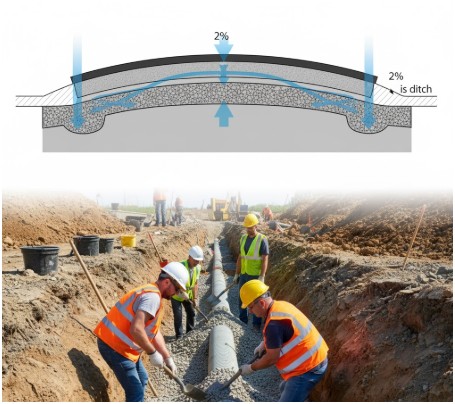High-traffic areas like commercial parking lots, industrial access roads, and major thoroughfares are subjected to immense stress daily.
The constant weight and movement of heavy vehicles, such as trucks and buses, can quickly lead to pavement deterioration, including cracks, potholes, and rutting.
To ensure safety, reduce long-term maintenance costs, and maintain a professional appearance, achieving superior pavement quality from the outset is not just an option—it’s a necessity.
Building pavement that can withstand this relentless pressure requires a strategic approach that goes beyond standard construction practices.
This guide outlines four essential steps for constructing durable, long-lasting pavement designed for the unique challenges of heavy-traffic environments.
How to Enhance Pavement Durability in Heavy-Traffic Zones
1. Prioritize a Robust Foundation

The long-term performance of any pavement is directly tied to the quality of its foundation. A weak or improperly prepared subgrade will inevitably lead to premature failure, no matter how well-designed the surface layer is. For areas expecting heavy loads, the subgrade and aggregate base layers are the unsung heroes of pavement durability.
The subgrade, which is the native soil beneath the pavement structure, must be thoroughly evaluated for its load-bearing capacity, moisture content, and stability.
In many cases, soil stabilization techniques—such as mixing in cement, lime, or fly ash—are necessary to improve its strength and reduce susceptibility to swelling or shrinking due to moisture changes.
Above the subgrade sits the aggregate base course, typically composed of crushed stone or gravel. This layer plays a crucial role in distributing the loads from the surface down to the subgrade, preventing stress from concentrating in one area. For heavy-traffic applications, a thicker and more densely compacted aggregate base is required.
Compaction is a critical step; achieving at least 95% of the material’s maximum density ensures a stable, uniform foundation that can effectively support the overlying asphalt or concrete layers and resist deformation under constant heavy loads.
2. Select High-Performance Pavement Materials

The material chosen for the surface layer must be specifically engineered to handle the demands of heavy traffic. Standard asphalt or concrete mixes may not be sufficient.
For asphalt pavements, this often means using a Superpave (Superior Performing Asphalt Pavements) mix design. Superpave systems allow engineers to create asphalt mixtures tailored to specific climate conditions and traffic loads.
This includes selecting the right type of binder (the black “glue” that holds the aggregate together) and aggregate structure to resist rutting in hot weather and thermal cracking in cold weather—two common failure modes in heavy-duty environments. The use of polymer-modified binders can further enhance the asphalt’s flexibility and durability, providing superior resistance to fatigue.
For concrete pavements, durability under heavy loads is achieved through a combination of high-strength mix designs and proper reinforcement. This may involve using a lower water-to-cement ratio to increase compressive strength, incorporating steel reinforcement like rebar or mesh to manage tensile stresses, and adding supplementary materials such as silica fume or fly ash to improve density and reduce permeability.
Choosing the right material isn’t just about initial strength; it’s about selecting a mix that will maintain its integrity over decades of constant use and environmental exposure.
3. Implement a Strategic Drainage System

Water is one of the most significant enemies of pavement. When water infiltrates the pavement structure and saturates the base and subgrade layers, it severely weakens their load-bearing capacity. This is especially problematic in heavy-traffic areas, where the combination of water and heavy loads can rapidly accelerate deterioration.
An effective drainage plan is therefore non-negotiable for achieving superior pavement quality. This begins with designing the pavement surface with an adequate cross slope, typically around 2%, to ensure that rainwater sheds quickly to the edges rather than pooling on the surface.
Beyond surface runoff, subsurface drainage is equally important. This often involves installing a system of perforated pipes, known as underdrains, along the edges of the pavement. These pipes collect water that seeps into the aggregate base and channel it away from the pavement structure.
In some designs, a drainage layer of open-graded, highly permeable aggregate is placed directly beneath the surface layer to facilitate rapid horizontal water movement. By preventing water from becoming trapped within the pavement system, you protect the foundation from weakening and extend the service life of the road significantly.
Over time, even the best-laid surfaces may require maintenance, so having a plan for services like asphalt repair in Ogden, UT can be crucial for addressing any issues that arise.
4. Ensure Precision in Installation and Quality Control

The most robust designs and highest-quality materials will fail if not installed correctly. Strict adherence to best practices during construction is essential for long-term performance.
For asphalt paving, this means maintaining consistent temperatures for the asphalt mix from the plant to the paver, applying the material in uniform lifts (layers), and achieving proper compaction before it cools.
Compaction is particularly vital, as it creates a dense, impermeable surface that resists both traffic loads and water penetration. Using the correct type and number of rollers and following a precise rolling pattern are key to achieving the specified density without crushing the aggregate.
For concrete paving, quality control involves ensuring the mix is consistent, placing the concrete at the correct thickness, and finishing the surface properly to achieve the desired texture and smoothness. Perhaps most importantly, proper curing is critical.
Final Words on How to Enhance Pavement Durability
Curing is the process of maintaining adequate moisture and temperature in the concrete for a period after it’s placed, allowing it to achieve its full design strength. Without proper curing, the surface can be weak, porous, and prone to cracking.
Throughout the entire construction process, regular testing of materials and workmanship—from subgrade density tests to asphalt core samples—is necessary to verify that all specifications are being met, ensuring the final product is built to last.






